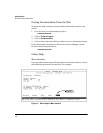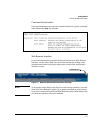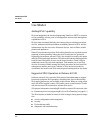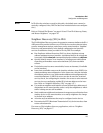
2-5
Introduction to IPv6
Migrating to IPv6
Connecting to Devices Supporting IPv6 Over IPv4
Tunneling
The switches covered by this guide can interoperate with IPv6/IPv4 devices
capable of tunneling IPv6 traffic across an IPv4 infrastructure. Some examples
include:
■ traffic between IPv6/IPv4 routers(router/router)
■ traffic between an IPv6/IPv4 router and an IPv6/IPv4 host capable of
tunneling (router/host)
Note Tunneling requires an IPv6-capable router. A switch running software release
K.13.01 does not route or tunnel IPv6 traffic. To enable IPv6 traffic from the
switch to be routed or to be tunneled across an IPv4 network, it is necessary
to connect the switch to an appropriate IPv6-capable router. For more infor-
mation, refer to the documentation provided with the dual- stack (IPv4/IPv6)
routers you plan to use for this purpose.
IPv6 tunneling eases IPv6 deployment by maintaining compatibility with the
large existing base of IPv4 hosts and routers. Generally, the various IPv6
tunneling methods enable IPv6 hosts and routers to connect with other IPv6
hosts and routers over the existing IPv4 Internet.
Information Sources for Tunneling IPv6 Over IPv4
For more information on IPv6 routing and tunneling, refer to the documenta-
tion provided with the IPv6/IPv4 routing and tunneling-capable devices in your
network. Some other sources of information are:
■ RFC 2893: “Transition Mechanisms for IPv6 Hosts and Routers”
■ RFC 2401: “Security Architecture for the Internet Protocol”
■ RFC 2473: “Generic Packet Tunneling in IPv6 Specification”
■ RFC 2529: “Transmission of IPv6 via IPv4 Domains without Explicit
Tunnels”
■ RFC 3056: “Connection of IPv6 Domains Over IPv4 Clouds”


















